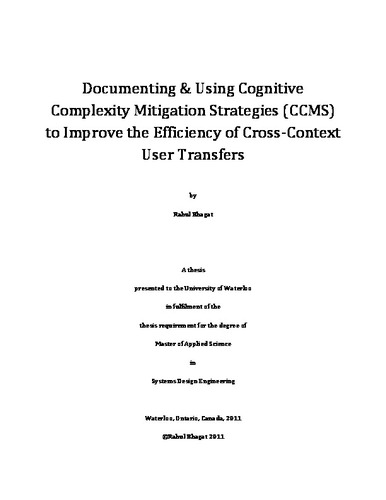| dc.description.abstract | Cognitive complexity mitigation strategies are methods and approaches utilized by users to reduce the apparent complexity of problems thus making them easier to solve. These strategies often effective because they mitigate the limitations of human working memory and attention resources. Such cognitive complexity mitigation strategies are used throughout the design, development and operational processes of complex systems. Thus, a better understanding of these strategies, and methods that leverage them, can help improve the efficiency of such processes.
Additionally, changes in the use of these strategies across various environments can identify cognitive differences in operating and developing across these contexts. This knowledge can help improve the effectiveness of cross-context user transfers by suggesting change management processes that incorporate the degree of cognitive difference across contexts.
In order to document cognitive complexity mitigation strategies and the change in their usage, two application domains are studied. Firstly, cognitive complexity mitigation strategies used by designers during the engineering design process are found through an ethnographic immersion with a participating engineering firm, followed by an analysis of the designer's logbooks and validation interviews with the designers. Results include identification of five strategies used by the designers to mitigate design complexity. These strategies include Blackbox Modeling, Whitebox Modeling, Decomposition, Visualization and Prioritized Lists. The five complexity mitigation strategies are probed further across a larger sample of engineering designers and the usage frequency of these strategies is assessed across commonly performed engineering design activities which include the Selection, Configuration and Parametric activities. The results indicate the preferred use of certain strategies based on the engineering activity being performed. Such preferential usage of complexity mitigation strategies is also assessed with regards to Original and Redesign projects types. However, there is no indication of biased strategy usage across these two project characterizations. These results are an example of a usage-frequency based difference analysis; such analyses help identify the strategies that experience increased or reduced usage when transferring across activities.
In contrast to the first application domain, which captures changes in how often strategies are used across contexts, the second application domain is a method of assessing differences based on how a specific strategy is used differently across contexts. This alternative method is developed through a project that aims to optimize the transfer of air traffic controllers across different airspace sectors. The method uses a previously researched complexity mitigation strategy, knows as a structure based abstraction, to develop a difference analysis tool called the Sector Abstraction Binder. This tool is used to perform cognitive difference analyses between air traffic control sectors by leveraging characteristic variations in how structure based abstractions are applied across different sectors. This Sector Abstraction Binder is applied to two high-level airspace sectors to demonstrate the utility of such a method. | en |

